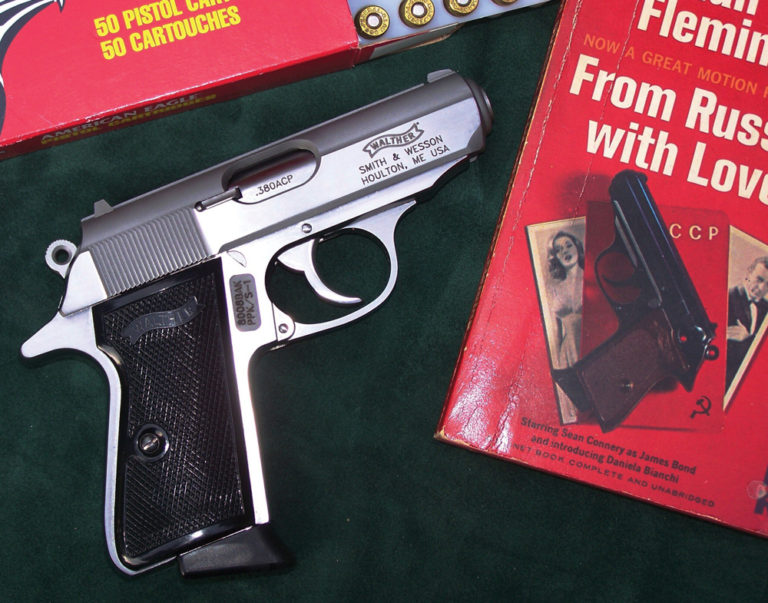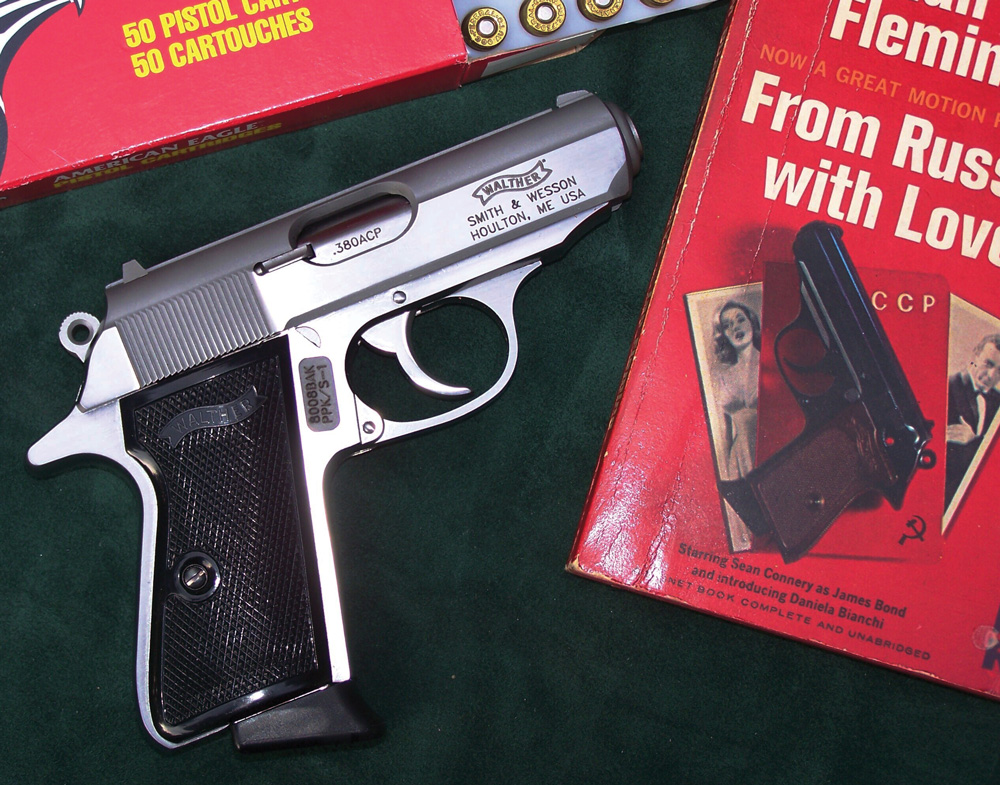

When an earlier story on carry calibers wrongly omitted the .380, Gun Digest readers sounded off. We heard you loud and clear.

Perhaps one of the best scenes in the classic “Casablanca” was right near the end, when Humphrey Bogart’s Rick Blaine squared off with Conrad Veidt’s sinister German Major Heinrich Strasser.
The goose-stepping villain was armed with a Luger, but Bogey’s gun was a Colt Model 1908, a flat, hammerless, semiautomatic pistol chambered for the .380 ACP cartridge. Leave it to the movies to show that a snarling Nazi schweinehund (pig-dog) was no match for a sarcastic Yank armed with one of the finest pocket pistols on the planet.
No guessing is necessary. Hitler’s tin soldier took a lead siesta as the local coppers rounded up the usual suspects, and the audience probably cheered all the way to the refreshment stand. It was 1942 after all, and nobody on American soil liked the Third Reich unless they were raving lunatics.
Proof positive that tough guys and .380-caliber pistols have an unfair advantage, especially when they’re letting Ingrid Bergman fly off to safety with another man.
But let’s get past the nostalgia and note for the record that a while back, when I discussed in these pages the top choices for personal protection, several Gun Digest readers were miffed that I had inadvertently left out the .380 ACP.
Well, I admit, it’s certainly not my first choice for defensive work, but when the chips are down and you need something to go “BANG!” with positive results, you could do a lot worse than the .355-caliber round that has also been called the 9mm Kurz or 9mm Corto.
The ammo has seen use in such classics as the Walther PPK, Beretta Model 1934, the aforementioned Colt and similarly-sized Browning Model 1910 pistol made by FN, the Colt Mustang, Sig Sauer P238, Ruger LCP, KelTec P-3AT, Kahr and so many other compact handguns it’s impossible to identify them all.
General George Patton may have carried a Colt .380 in his waistband as a hideout gun. And who can forget the scene in the film biography, “Patton,” starring George C. Scott, when he jumped off a balcony, onto a truck, and then down to a street in some desert town to fire that little pistol at a strafing German aircraft?
.380 Pistols and a Likable Round

Few people say they hate the little round, especially after it was written about in the Nosler Reloading Guide No. 7 (Page 620).
Over the years, I’ve run across people who even handload the .380, a task for which I probably wouldn’t have the patience. When it comes to small cartridges, I’m pretty much all thumbs at the loading bench.
Back in the day, when this cartridge was first introduced, it was available only with a 95-grain FMJ bullet. At close range, that round could ruin somebody’s day, but leap ahead four generations—the cartridge was introduced in 1908—and the crafty ammunition developers at Federal, Winchester, Remington, Speer and other companies have cooked up some remarkably effective loads in that caliber.
Chalk the better loads up to new bullet designs and the development of better propellants.
CorBon produces a 90-grain hollowpoint +P load with an advertised muzzle velocity of 1,050 feet per second (fps), while JHP loads from Federal, Winchester, Hornady and CCI/Speer can warp out of a barrel at 1,000 fps.
Federal’s load features a 90-grain Hydra Shok and Hornady’s is topped with a 90-grain XTP. The CCI load has an 88-grain JHP, and Winchester loads an 85-grain Silvertip. You do not want to be on the receiving end of any of these rounds.
That’s probably why the .380 ACP (which stands for Automatic Colt Pistol) just refuses to die. Truth be told, I’ve shopped around for a decent Model 1908 for some time now, and haven’t been able to find one that is affordable.
I’ve run across some beaters—guns that have most of the bluing worn away or with visible pitting from corrosive years of neglect—which the owners must have thought were new in the box for the prices they were asking. I’ve seen a few really decent specimens as well, but would have had to refinance my house to pay for them.
In Pursuit of a PPK

I also pursued a decent PPK for a while, and admit to having had quick, emotional affairs with the Sig, Ruger and Colt Mustang models. Depending upon the individual pistol model, I’ve gotten some remarkable ballistics from the .380 ACP over the years in different gun tests.
Nobody could seriously compare the .380 ACP with the .40 S&W, .45 ACP or .357 Magnum as a fight stopper, but if it’s all you have when you need a gun, you’ve got a lot more than you might think.
For one thing, I’ve discovered on repeated occasions that in subdued light this round produces a muzzle flash and muzzle blast out of a short barrel that is rather impressive. Another thing I’ve discovered is that out to 50 yards and maybe a bit beyond, this is a fairly flat-shooting round.
Some years ago, I built an inside-the-waistband (IWB) rig for my pal David Gross, a Minnesota attorney and gun rights activist, who has carried his Model 1910 Browning frequently because he needed a flat, reliable pistol that could vanish under a casual jacket.
I knocked together a belt holster for another pal’s vintage Llama pistol that was about the same size as the Colt Mustang.
Perhaps that is the real advantage of this cartridge. The guns for which it is designed are all rather compact little numbers that can be carried in a pocket or ankle holster, a small IWB or shoulder holster, and nobody is any the wiser.
There is still a lot of life in the .380 ACP, and don’t be surprised if 2014 sees one or two more new pistols chambered for the cartridge.
With more than eight million people licensed to carry across the United States by some estimates, there is a lot of demand for quality, concealed handguns. It may not stop a grizzly, but it can stop a fight or an assault, and that’s really the bottom line.
This article appeared in the December 2, 2013 issue of Gun Digest the Magazine.

Next Step: Get your FREE Printable Target Pack
Enhance your shooting precision with our 62 MOA Targets, perfect for rifles and handguns. Crafted in collaboration with Storm Tactical for accuracy and versatility.
Subscribe to the Gun Digest email newsletter and get your downloadable target pack sent straight to your inbox. Stay updated with the latest firearms info in the industry.








Minor thing: In “Patton”, George C. Scott was carrying a .32 ACP 1903 Colt. That was the General Officer’s issue pistol up until WW2, when they went to the General Officer’s Model .45, very similar to today’s Officer’s ACP. When I was an MP Company Armorer, I was allowed to fire a magazine full from our Commanding General’s pistol. May have been the most beautiful pistol I have ver been allowed to touch.
According to this article, Rick in “Casablanca” is actually armed with the .32 ACP version, the Colt 1903 Pocket Hammerless: https://www.imfdb.org/wiki/Casablanca#Colt_Model_1903.2F1908
I took a 290 pound Russian wild boar with a Kahr P380 at 25 yards and 3 shots, any of which would have been fatal. It’s all about shot placement…
My 2 carry guns for many years have been a Colt 1903 and a Walter PPK. Both very flat and easy to conceal, however both are in .32 ACP (just like James Bond’s PPK) and have never failed to feed silvertips or any other ammo I tried.
“As far as modern made Walthers or other .380′s, reliability is never guaranteed . . . .” Reliability is never guaranteed in any gun, whether built in 1940 or 2010. I have an LCP that is 4 years old, it has never malfunctioned, even when I have neglected cleaning it after two or three practice sessions in a row. Fires every type of 380 ammo I’ve purchased, roughly a dozen, including reloaded Golden Sabers. I also have a Browning BDA 380 which has been flawless for he past 3 years. Each of these have had at least 500 rounds run through them. So, when is a gun considered flawless, when it runs 1000, 2000, 4000 or until it fails the first time? Most every gun I own is flawless, except for a couple Sigs and a Ruger MK III.
Correction. General Patton’s 380 was not a Colt. It was a Remington Model 51. Its serial number is known and published but current whereabouts of the pistol is not.
There are other notables in .380 ACP also.. The Makarov was imported as a .380 by KBI for example and is about as reliable as guns get. I also reload the .380 and even cast bullets with powder coat that work great for it. The Ruger LCP is my favorite pocket pistol also. Will it stop an elephant? NO.. but any 9mm bullet that hits an intruder will certainly ruin his day regardless of its a 115gr or 100gr. Personally I think its a great little cartridge.
With so many modern super small 9mm guns that are as small as many .380’s I sometimes wonder why people still buy a .380 at all. Of course there is reliability which only comes with some of the very old model .380 guns like the French and German made Walther’s. The 1910 Browning also comes to mind. As far as modern made Walthers or other .380’s reliability is never guaranteed because of poor workmanship and substandard materials like junk MIM cast parts that are known for early failure and that pertains to the bigger calibers as well so there is a reason some people carry the 0lder model .380 guns because they know they will work if ever needed and they are vey concealable. Too bad we do not have any modern guns this size in 9mm that can be counted on to work.
If you’re quick you could catch this one: https://www.gunbroker.com/Auction/ViewItem.aspx?Item=400283363